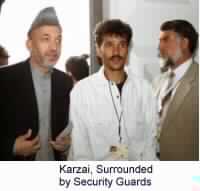HIGHLIGHTS: Loya Jirga Fails to Dislodge Powerful Regional Warlords||6 Cabinet Posts Go To Pashtun But Tajiks Hold on to Defense & Foreign Affairs, Interior Goes to Wardak, Pashtun||Regional Representatives to Name Council, which in Turn Selects Parliament|| STORY: Afghanistan's grand council adjourned Wednesday after swearing in Hamid Karzai as president and approving a new government to begin the long process of rebuilding a nation shattered after 23 years of war.
However, many of the 1,650 delegates complained that the nine-day council, or loya jirga, failed to dislodge the powerful regional warlords and had left key posts such as defense in the hands of an ethnic Tajik clique opposed by the country's dominant Pashtun community.
"Some of the Cabinet is good, some is not," delegate Mohammed Daoud said. "Warlords are still there."
Karzai, who was elected president Thursday, told the delegates that he had worked hard to put together a Cabinet that was both qualified and representative of the country's ethnic mix. He encouraged delegates to "take weapons and fight me" if the government failed to keep its promises.
Karzai also declared that terrorists would not be allowed to operate again in Afghanistan and promised to "relieve Afghanistan of this pain."
He took his oath at the end of the session. His government will rule for 18 months until new elections. It will also appoint a commission to draft a new constitution.
Six of the 13 Cabinet posts went to Pashtuns, who had complained of being marginalized since the collapse of the Taliban, who were mostly Pashtuns.
Many observers believe that no Afghan government can succeed unless it is accepted by the Pashtuns. Karzai, who led the former interim administration, is a Pashtun. But many Afghans believed Karzai's power was limited by an ethnic Tajik clique in his interim administration.
Three posts went to ethnic Tajiks from the opposition northern alliance, which seized Kabul last year after the Taliban fled the city under relentless U.S. bombing.
However, the Tajiks held onto two of the most important ministries - foreign affairs and defense. Defense Minister Mohammed Fahim was also named one of three deputy presidents. Dr. Abdullah remains foreign minister.
Fahim was believed backed by the United States, which wanted continuity in the powerful post as it seeks to build a national army capable of defending the country after the U.S.-led coalition withdraws.
In the outgoing interim administration, the Tajiks also held the interior ministry, which controls the police and is the most powerful post after defense. However, the outgoing minister, Yunus Qanooni, announced this week that he was ready to give up the job and refused Karzai's offer of the education ministry.
The interior minister post went to an ethnic Pashtun, Taj Mohammed Wardak, who returned to Afghanistan last year after living in California. However, Wardak is in his late 70s and was seen by some delegates as too weak for such a stressful position.
The loya jirga, which opened June 11, had been seen as the best opportunity in decades for Afghanistan to build a lasting peace because it brought together democratically chosen delegates from throughout this factious country to agree on a new form of government.
The council failed to select a parliament. Instead, a limited number of representatives of the country's regions will stay behind to name a commission that would in turn select the legislature.
PHOTO CAPTION
Afghanistan's newly elected President Hamid Karzai, left, along with security guards, arrives at the grand council, or loya jirga Tuesday, June 18, 2002 in Kabul. (AP Photo/Amir Shah)
- Author:
& News Agencies - Section:
WORLD HEADLINES


 Home
Home Discover Islam
Discover Islam Quran Recitations
Quran Recitations Lectures
Lectures
 Fatwa
Fatwa Articles
Articles Fiqh
Fiqh E-Books
E-Books Boys & Girls
Boys & Girls  Hajj Rulings
Hajj Rulings Hajj Fatwas
Hajj Fatwas














